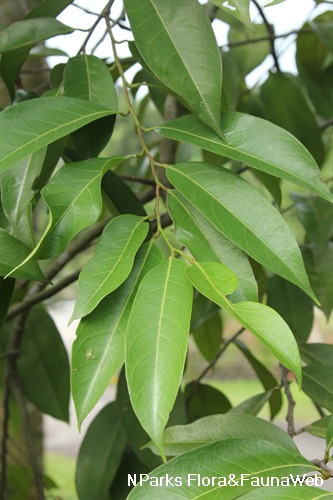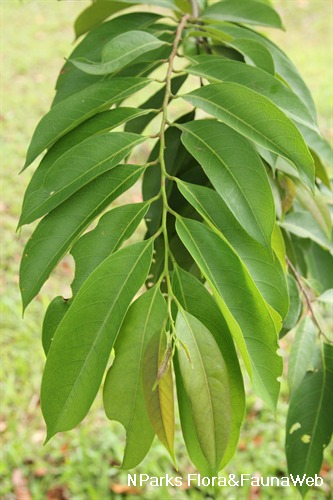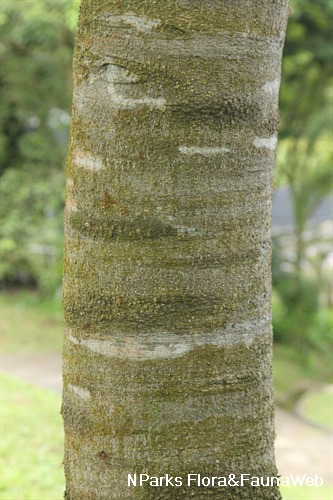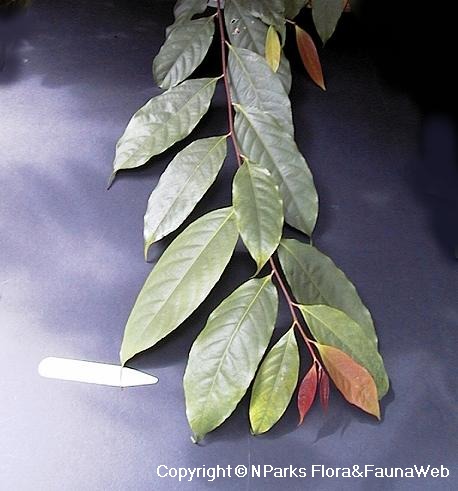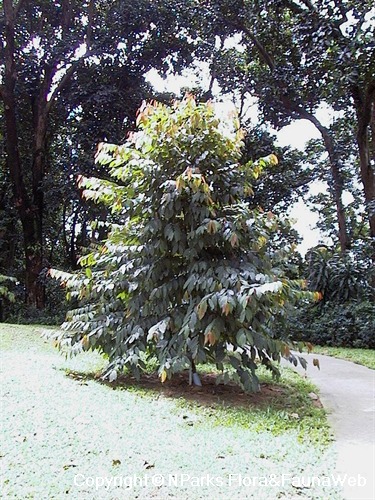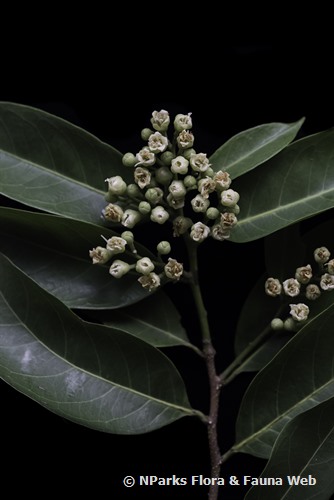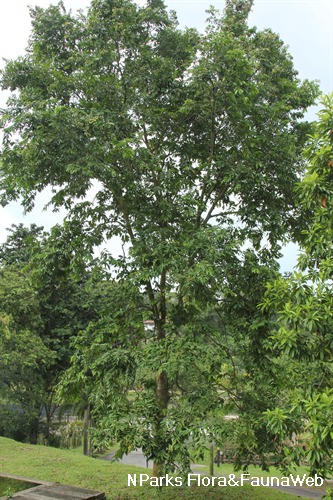
Back
Maranthes corymbosa Blume
| Family Name: | Chrysobalanaceae |
| Synonyms: | Parinarium corymbosum (Blume) Miq., Atuna corymbosa, Parinarium griffithianum Benth. |
| Common Name: | Merbatu, Sea Beam, Kayu Batu, Kayu Kambang, Kembang Batu, Merbatu Layang, Sau Hutan |
Name
Classifications and Characteristics
| Plant Division | Angiosperms (Flowering Seed Plants) |
|---|---|
| Plant Growth Form | Tree (Big (>30m)) |
| Lifespan (in Singapore) | Perennial |
| Mode of Nutrition | Autotrophic |
| Plant Shape | Irregular |
| Maximum Height | 40 m |
Biogeography
| Native Distribution | Thailand, Peninsular Malaysia, Singapore, Sumatra, the Philippines, Borneo, Java, Sulawesi, the Moluccas, New Guinea, Australia and the Solomon Islands. |
|---|---|
| Native Habitat | Terrestrial (Primary Rainforest, Secondary Rainforest, Coastal Forest) |
| Preferred Climate Zone | Tropical |
| Local Conservation Status | Native to Singapore (Vulnerable (VU)) |
Description and Ethnobotany
| Growth Form | It is a tree up to 40 m tall. |
|---|---|
| Foliage | Its alternate, stalked, leaves have leathery leaf blades that are oblong-lance-shaped or oblong-oval, and 6.5-14 by 2.5-8 cm. Its leaves have 2 prominent glands at the junction of the leaf stalk and the lower leaf surface. |
| Flowers | Its flowers are about 10 mm wide and grow on branched flowering shoots. Its white petals have a tinge of pink and 3-6 mm long. |
| Fruit | Fruit is ellipsoid and 3-4 by 1.5-2 cm. |
| Habitat | It grows in coastal areas, primary and secondary forests, up to 1500 m altitude. It occurs locally in Pulau Ubin and Pulau Tekong. |
| Cultivation | It can be propagated by seed. |
| Etymology | Greek maraino, to wither, referring to the long-persistent withered calyx and stamens found below the fruit; Greek corymbos, a cluster, referring to the clustered flowering shoots |
| Ethnobotanical Uses | Edible Plant Parts : Edible Fruits Timber & Products: Its timber is used for the construction of houses and as posts. Cultural / Religious: Heritage Tree : There are currently two individuals of Maranthes corymbosa listed as Heritage Trees in Singapore. Both can be found at Fort Canning Park. To find out more about these trees, please visit the Heritage Tree Register. |
Landscaping Features
| Landscaping | It is suitable for planting along streetscapes and in parks and gardens for its bushy crown. |
|---|---|
| Desirable Plant Features | Ornamental Form |
| Landscape Uses | General, Suitable for Roadsides, Parks & Gardens, Small Gardens, Coastal |
Fauna, Pollination and Dispersal
| Pollination Method(s) | Biotic (Fauna) |
|---|---|
| Seed or Spore Dispersal | Biotic (Fauna) |
Plant Care and Propagation
| Light Preference | Full Sun |
|---|---|
| Water Preference | Moderate Water |
| Plant Growth Rate | Moderate |
| Rootzone Tolerance | Moist Soils, Well-Drained Soils, Saline Soils / Salt Spray, Fertile Loamy Soils |
| Maintenance Requirements | Moderate |
| Propagation Method | Seed |
Foliar
| Foliage Retention | Evergreen |
|---|---|
| Mature Foliage Colour(s) | Green |
| Mature Foliage Texture(s) | Leathery |
| Prominent Young Flush Colour(s) | Red |
| Young Flush Texture(s) | Leathery |
| Foliar Type | Simple / Unifoliate |
| Foliar Arrangement Along Stem | Alternate |
| Foliar Attachment to Stem | Petiolate |
| Foliar Shape(s) | Non-Palm Foliage |
| Foliar Venation | Pinnate / Net |
| Foliar Margin | Entire |
| Leaf Area Index (LAI) for Green Plot Ratio | 4.0 (Tree - Dense Canopy) |
Floral (Angiosperm)
| Flower Colour(s) | Pink, White |
|---|---|
| Flower Grouping | Cluster / Inflorescence |
Fruit, Seed and Spore
| Mature Fruit Colour(s) | Green |
|---|---|
| Fruit Classification | Simple Fruit |
| Fruit Type | Fleshy Fruit |
Image Repository
Others
| Master ID | 1724 |
|---|---|
| Species ID | 3017 |
| Flora Disclaimer | The information in this website has been compiled from reliable sources, such as reference works on medicinal plants. It is not a substitute for medical advice or treatment and NParks does not purport to provide any medical advice. Readers should always consult his/her physician before using or consuming a plant for medicinal purposes. |

